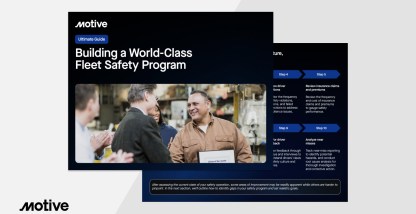Heavy equipment transportation requires proper planning, whether the machinery is hauled across state lines or just down the road. Loading and unloading takes additional care, and there are regulations to comply with when shipping heavy equipment. These top tips for heavy equipment transport can help fleet managers ensure safety and efficiency.
What is heavy equipment transportation?
Heavy equipment transportation is a subset of the transportation industry dealing with heavy, oversized loads. It involves moving oversize equipment and machinery using trucks and specialized trailers that can haul thousands of pounds or more.
What’s considered heavy equipment?
There are many different types of heavy equipment used across industries. Construction, industrial, oil and gas, military, marine, forestry, and agricultural organizations often use heavy equipment transportation. The cargo could include backhoes, excavators, rock trucks, loaders, graders, and more.
The weight of heavy equipment can vary. The federal government classifies cargo as a heavy load when it exceeds:
- 80,000 pounds of gross vehicle weight
- 20,000 pounds of single axle weight
- 34,000 pounds of tandem axle weight
What are the challenges of heavy equipment transportation?
Transporting overweight, oversize equipment presents unique challenges. This section will examine the main challenges fleet managers face.
Safety
Attention needs to be paid to securing the equipment. Not only for the safety of the driver hauling the heavy load but also for the safety of others on the road. Safely loading and unloading heavy equipment is another challenge. The labor involved in loading should be qualified and experienced in this particular area of shipping.
Rules and Regulations
Heavy equipment shipping concerns make this a highly regulated area of transportation. Fleet managers and drivers will need to know the rules and regulations that apply.
Not knowing the different regulatory requirements for size and weight can prove costly. The Department of Transportation has jurisdiction over heavy loads on the road, but each state does things differently. Most states require a heavy haul permit, but what qualifies as overweight can vary from one state to the next. The rules about signage, flags, escorts, and accepted transport vehicles can also change depending on size, weight, and route.
Further, licensed heavy equipment transportation companies are legally required to carry liability and cargo insurance.
Planning logistics
Fleet managers must keep safety and regulations in mind when planning the route for a heavy load. There may be restrictions on how equipment is secured to a trailer or when the vehicle can be on the road.
The company also needs to have the right vehicles available. A flatbed truck may work in most situations, but don’t be surprised by the need for a heavy-duty, tri-axle lowboy.
You’ll need knowledgeable people to load or unload safely. Driver expertise with heavy hauling should factor in too when considering driver hours of service availability. Inexperienced drivers soon recognize that a heavy load changes their vehicle’s handling.
Tips for loading and unloading heavy equipment safely
Loading and unloading cargo can be dangerous. This is especially true with heavy equipment.
Perform and document a risk assessment
Prepare for each heavy haul engagement by developing a thorough process to prepare equipment and personnel for transportation and offloading. There should be a senior manager or supervisor involved in determining risks and what can be done to address them. You’ll also want to document the plan to preemptively address any compliance concerns.
Train your employees
Shipping a tractor isn’t the same as shifting a pallet. The equipment is likely to be an awkward shape in addition to its weight and size. Heavy hauling is also expensive. Your business doesn’t want to risk anything happening to expensive assets while your people are handling them.
Document your processes and ensure that all employees are fully trained in best practices for loading and unloading. Make sure they also have access to all the appropriate personal protective equipment (PPE) they might need.
Do a vehicle pre-inspection
Heavy equipment puts a lot of pressure on the vehicle asset. Before loading, verify the truck or trailer is up to the task. Create customized vehicle inspection procedures to inspect tires, lights, brakes, and tie-down points. You should also confirm weight load limits.
Clear the loading/unloading area
Having a clean ramp and trailer area cleared of obstacles makes it easier to load heavy equipment safely. Remove ice, snow, or water from the ramp and trailer bed to ensure smooth movement. Avoid loading and unloading during peak hours or when the dock is heavily occupied to prevent obstacles.
Properly secure equipment
The manufacturer will often provide instructions and engineering guidelines to secure and stabilize equipment during travel. When tying down the heavy equipment:
- Use heavy-duty chains that are tight enough to prevent movement or shifting, ensuring that equipment remains secure while the vehicle is en route.
- Locate proper tie-down points. Using appropriate points prevents equipment damage and helps ensure security.
- Align chain and hook binder grades to meet your working load limit.
- Immobilize the wheels of any equipment using wedges, chocks, or cradles.
Tips for the safe transportation of heavy equipment
Transporting heavy equipment requires extra care. The following best practices can help you prioritize safety.
Read the manual
Heavy equipment manuals can recommend transport procedures. They often help identify vulnerable equipment parts and suggest ways to reduce or eliminate damage.
Know the route
Planning the route in advance helps optimize for factors that could impact driver and equipment safety. Avoiding traffic, construction, or driving in bad weather simplifies transport. Anticipating the route also helps you know which permits are needed along the way. Make advance arrangements to avoid excessive idling or deadhead driving.
Drive sensibly
Heavy haul drivers know this is a more challenging load to transport. When braking, reversing, turning, changing lanes, or driving uphill or downhill, a vehicle with a heavier load will feel force differently than another truck or trailer.
Maintaining a space cushion, driving without distraction, and following posted speed limits are always good choices. But sensible driving practices are all the more important when a heavier load is on the road.
Have a response plan
Thinking ahead about what you will do if something goes wrong can help you react more efficiently and effectively. For example, flagging and escorts can help enhance safety when encountering an accident on the road.
Risks to consider when shipping heavy equipment
You risk costly fines if you don’t meet the specific regulations for load weight, height, or length. Research the rules for each jurisdiction along your route to proactively document and permit where necessary.
Weather conditions can also factor into safety on the road. A heavy haul truck handles differently from the start. Add rain, snow, or sleet and extra precautions are needed.
Rough road conditions can also be problematic. Highway potholes could cause equipment to become loose. That poses a danger in transit and upon unloading.
How Motive supports heavy equipment hauling and transportation
Motive’s all-in-one fleet management solution helps streamline business processes. The centralized dashboard lets managers know where drivers, assets, and equipment are — in real time. GPS-based fleet tracking and geofence warnings let you track heavy equipment and prevent theft.
Planning for heavy-haul trips is simplified with route optimization powered by AI. Motive can also help you manage and monitor budget, driver availability, fuel consumption, and vehicle status.
Our technology also supports driver safety, helps prevent accidents, and mitigates risk by combining telematics, AI, and video footage, to identify high-risk behaviors.
Request your demo of Motive’s innovative technology to support your productivity and profitability.










